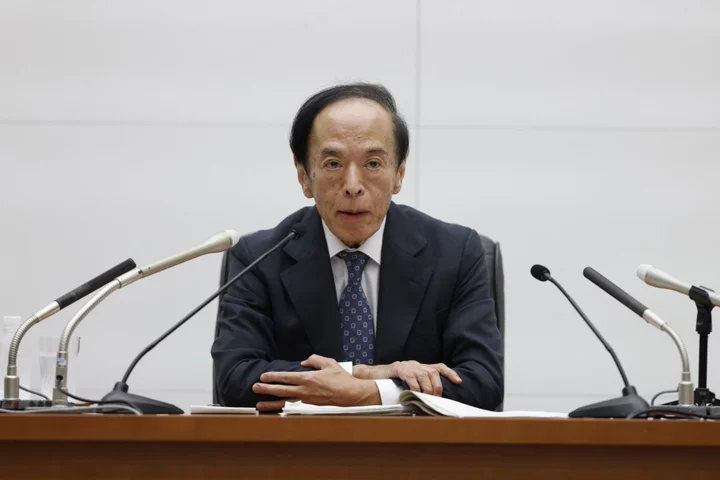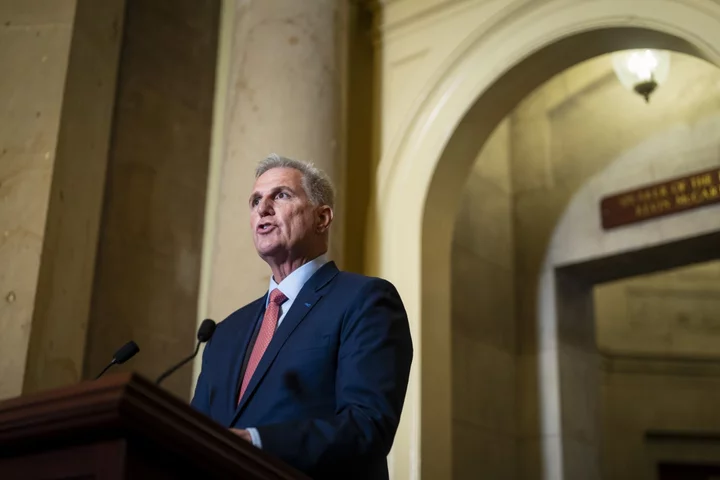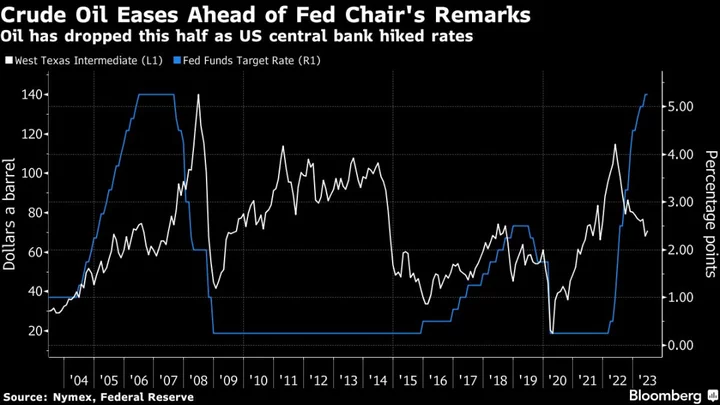The Bank of Japan’s Kazuo Ueda is in a tight spot. If he stands pat on policy this week he risks sending the yen to a multi-decade low and opening up his yield control program to speculative attack in the market.
At the same time, if he raises the ceiling on 10-year yields under yield curve control — explicitly or implicitly — the governor may invite long-term rates to rise to levels inconsistent with economic fundamentals, jeopardizing his goal of achieving stable inflation.
In a sign of just how fraught the discussions on policy may be, BOJ officials are likely to monitor yield movements until the very last minute before deciding on whether to adjust YCC, according to people familiar with the matter.
“The BOJ is in an extremely tough position,” said Tsuyoshi Ueno, senior economist at NLI Research Institute in Tokyo. “Whatever it does, it can’t make everybody happy.”
Most economists surveyed by Bloomberg think Ueda wants to see more evidence of wage growth and a more solid price trend before scrapping the BOJ’s negative interest rate next spring. Three-quarters of them think he can do that without adjusting policy settings during the two-day gathering that concludes on Tuesday.
The others disagree. They think Ueda has to make some kind of move to buy time if he doesn’t want to pivot on policy yet.
Three of the main factors fueling the speculation of a change in the pipeline are the yen, yields and prices.
The yen set a fresh year-to-date low last week, raising the specter of potential government intervention to prop it up. One of the main factors driving the currency’s weakness is the BOJ’s continued stimulus aimed at spurring inflation, a stance at odds with higher interest rates around the world aimed at suppressing price growth.
Government bond yields are meanwhile closing in on the bank’s 1% ceiling, a level the BOJ said in July was unlikely to be reached. The yield touched a fresh decade high of 0.885% last week, prompting additional bond-buying by the central bank to limit the upward movement. Each round of bond-buying serves as a reminder to investors of the BOJ’s ultra-easy policy, keeping downward pressure on the yen.
The extra bond purchases also raise questions about the effectiveness and even the viability of the bank’s easing program.
Back in 2016, when the bank was on pace to buy ¥119 trillion ($795 billion) in bonds, officials opted to move away from quantitative easing as it put in place yield curve control to make its stimulus more sustainable. But this year the bank is on track to match or even pass that record based on figures through Oct. 27 as it pulls out the stops to defend its framework.
“No other central bank has to face these complicated problems,” said NLI’s Ueno. “It shows the challenge of trying to stick with YCC.”
The other major challenge for Ueda is explaining how much distance is left before he achieves his inflation target. Already price growth has stayed above the BOJ’s 2% target for more than a year and half, prompting a raft of government measures to limit the cost-of-living crunch it has triggered, with more due in an economic package expected later this week.
The surprise acceleration in Tokyo consumer inflation in October will add pressure on policymakers. Friday’s data, a leading indicator for national trends, showed that prices excluding fresh food rose 2.7% in the capital.
The bank is expected to raise its price forecasts for this fiscal year and next at the meeting. That would mean the BOJ is forecasting Japan’s key inflation to stay above 2% for three consecutive years. That’s a feat the nation hasn’t attained since the early 1990s and it would beg the question of why the BOJ is keeping stimulus in place.
The latest take on the distance from achieving the goal, people familiar said, is that the bank’s target of stable inflation at 2% isn’t yet in sight despite progress largely in line with expectations. That suggests there won’t be any major moves toward policy normalization at the meeting, such as an end to negative rates.
Market players see more likelihood of change. Ten-year overnight-indexed swaps are already above the BOJ’s effective yield ceiling, suggesting traders are betting on or at least hedging against a rise in bond yields.
There are various options for adjusting the YCC settings if changes are made. They include simply raising the rate for daily fixed rate operations from the current 1%, scrapping a 0.5% reference point on yield movements and adjusting how the bank conducts the policy on a daily basis, according to the people familiar.
Raising the cap on yields would narrow the rate differential with the US, thereby helping ease pressure on the yen. It would also further pave the way toward a normalization of policy by allowing yields to move closer to freely traded levels.
But it would also weaken the power of the BOJ’s stimulus just as it appears to be closing in on its stable inflation goal after more than a decade of massive asset buying. It may also offer a signal of fear for market speculators on the prowl. The collapse of the Reserve Bank of Australia’s yield target in 2021 shows the risks of giving market players the impression a central bank is on the run.
What Bloomberg Economics Says...
“We expect the BOJ to lean against the pressure by stepping up JGB buying, assessing that the market moves aren’t justified by economic conditions or inflation expectations.”
— Taro Kimura, economist
For the full report, click here
The BOJ is likely to raise the de facto yield limit of 1% to 1.5% at the upcoming meeting “because the yield is already close to the current ceiling, which may encourage market players to test the line,” Shusuke Yamada, head of Japan currency and rates strategy at Bank of America in Tokyo, said in an interview.
Among the majority of economists seeing the BOJ standing firm for now, Shigeto Nagai, former head of BOJ’s international department, said changing the upper limit as a precaution against the impact of soaring US yields would render YCC meaningless.
Yet, Nagai, currently head of Japan economics at Oxford Economics, said the bank will probably continue to hint at the chance of ending negative rates or tweaking the YCC down the road, as that would be useful in reducing downward pressure on the yen.
Among the minority who see change Kentaro Koyama, chief Japan economist at Deutsche Securities and a former BOJ official, warns that the pressure on YCC could be extremely strong by the next meeting in December given the inflation outlook and rising market expectations for normalization
“It’s hard to imagine the BOJ will do nothing at this meeting,” he said.
--With assistance from Sumio Ito, Yumi Teso and Mia Glass.









